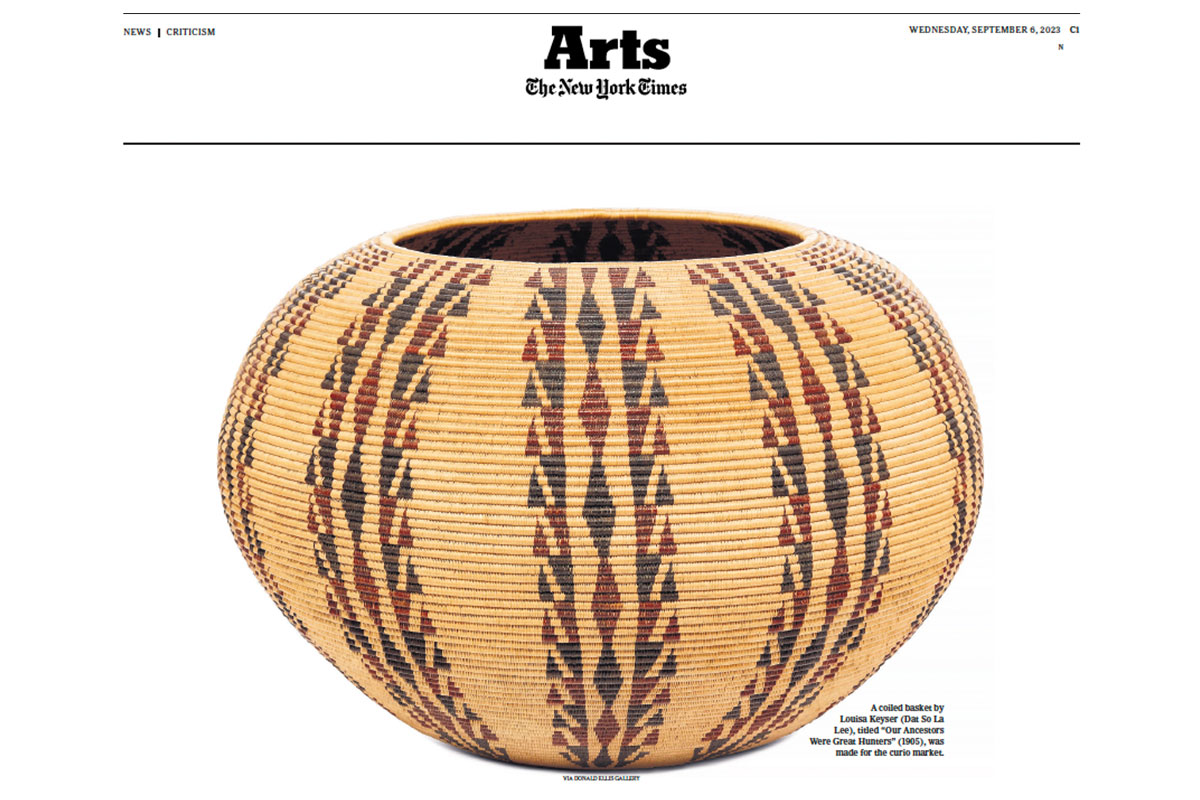
Louisa Keyser Praised in the New York Times
Marc Tracy examines the outstanding mastery of Keyser’s art while highlighting the complex artist-patron relationship that enabled it
1912
willow, redbud, bracken fern root
width: 17 ½"
Inventory # CS3577
Sold
Reportedly obtained from the artist in 1913 by a resident of Carson City, NV
Green Collection, Woodbury, NJ
Parke Bernet Galleries, New York, November 19, 1971, lot 141
The Woodstock Foundation, Woodstock, VT
James Economos, Santa Fe, NM, sold in 1995
Tom and Ann Cousins, Atlanta, GA
Donald Ellis Gallery, New York, NY, sold in 2008
Jane Katcher Collection, New York, NY
Wayne A. Thompson and Eugene S. Meieran, California Indian Basketry, Ikons of the Florescence, El Cajon: Sunbelt Publications, 2021, pg. 122, fig. 195
Jane Katcher, David A. Schorsch and Ruth Wolfe (eds.), Expressions of Innocence and Eloquence, Selections from the Jane Katcher Collection of Americana, Seattle: Marquand Books, 2011, pgs. 166-181 and 384-385, pl. 28
Donald Ellis Gallery catalogue, 2010, pgs. 44-45
Marvin Cohodas Phd, Dat So La Lee's Basketry Design, in: American Indian Art magazine, Autumn, 1976, pg. 22
State Museum of New Jersey, Trenton, NJ, 1962
Fenimore Art Museum, Cooperstown, NY, October 1-December 31, 2011
For related baskets and an essay on Dat So La Lee's work see: Marvin Cohodas Phd, Dat So La Lee's Basketry Design, in: American Indian Art magazine, Autumn, 1976, pgs. 22-31
Ralph T. Coe, Sherry Brydon, Gilbert T. Vincent (eds.) Art of the North American Indians: The Thaw Collection, Seattle: University of Washington Press, 2000, pg. 285, pl. T751
Bruce Bernstein and Gerald McMaster (eds), First American Art: The Charles and Valerie Diker Collection of American Indian Art, Seattle: University of Washington Press, 2004, pg. 238, pl. 187
Louisa Keyser, also known as Dat So La Lee (1850–1925), is celebrated as the most accomplished Native American basket weaver. Distinguished by her exceptional craftsmanship, Keyser was both a keeper of Native traditions and a distinctly modern innovator. She is most famous for developing the degikup style, large spherical baskets on a flat base.
The present coiled basket is typical of Keyser’s style, expanding out into the maximum circumference before tapering to a narrow hole in the top. Red and black geometric elements formed by bracken fern and redbud are evenly spaced across the surface. Traditionally, Washoe baskets were round, watertight containers made both for utilitarian and ceremonial purposes. Louisa Keyser transformed the relatively plain design of Washoe basketry into sculptural works for sale on the art market.
Born to the southern Washoe group, Louisa Keyser’s artistry was recognized by Abram and Amy Cohn, owners of the Emporium Company in Carson City, Nevada. For several decades, the Cohns acted as Keyser's sponsors and provided her with lodging, food and healthcare, allowing her to focus on developing her artistic practice. The Cohns documented every basket produced between 1895-1925, creating a veritable collectors field in the process. Propelled by the Arts and Crafts movement of the early 20th century, Keyser’s basketry sold for record prices at the time. Her art is in the permanent collections of many leading museums, including the Metropolitan Museum of Art, National Museum of the American Indian, Penn Museum, and Nevada State Museum.

Marc Tracy examines the outstanding mastery of Keyser’s art while highlighting the complex artist-patron relationship that enabled it